ExxonMobil Chemical
Advantages and benefits of SpectraSyn Elite™ 65 and SpectraSyn Elite™ 150 mPAO base stocks
By Michael P. Sheehan, Marketing Technical Services, ExxonMobil Chemical Company | TLT CMF Plus November 2013
Energy-efficient machinery and vehicles are placing increasingly tougher demands on lubricants. To meet these demands, ExxonMobil Chemical’s SpectraSyn Elite™ metallocene polyalphaolefin (mPAO) base stocks offer a unique molecular structure, enhanced properties and performance benefits in finished lubricant formulations. Metallocene-catalyzed SpectraSyn Elite™ 65 and 150 mPAO products are used in many advanced synthetic lubricants for both automotive and industrial applications.
Synthetic lubricants play a role in energy efficiency
Engine and equipment design innovations have helped further energy-efficiency gains and meet emissions-reduction requirements. To sustain those efficiency improvements, lubricants must handle the demands of more energy-efficient equipment. As original equipment manufacturers (OEMs) develop equipment with higher fuel economy and energy efficiency, lubricants are subjected to more severe operating conditions. At the same time, users demand longer drain intervals. Exxon Mobil Chemical believes this presents a tremendous opportunity for advanced synthetic lubricants. Part of the company’s mission is to develop synthetic base stocks that meet current and future demands of energy-efficient equipment. Compared to mineral base stocks, polyalphaolefin (PAO) base stocks offer:
•
higher viscosity index (VI)
•
lower-temperature fluidity
•
better oxidative and thermal stability
•
lower traction coefficient
ExxonMobil Chemical developed metallocene-catalyzed PAO (mPAO) base stocks, under the trade name SpectraSyn Elite™, with two viscosity grades (65 and 150 cSt). They have benefits beyond conventional high-viscosity PAO (cPAO) base stocks.
How are mPAOs different from conventional PAOs?
The use of metallocene catalysts in PAO production results in a molecular structure that differs significantly from cPAOs (
Figure 1). Conventional PAOs exhibit a random branched structure, while mPAOs show an orderly branched structure (more carbon atoms in side chains than in the backbone). This arrangement gives the mPAO molecule a more compact structure and a lower theoretical sweep volume, which translates into a lower thickening efficiency for mPAOs compared to equivalent-viscosity PAOs.
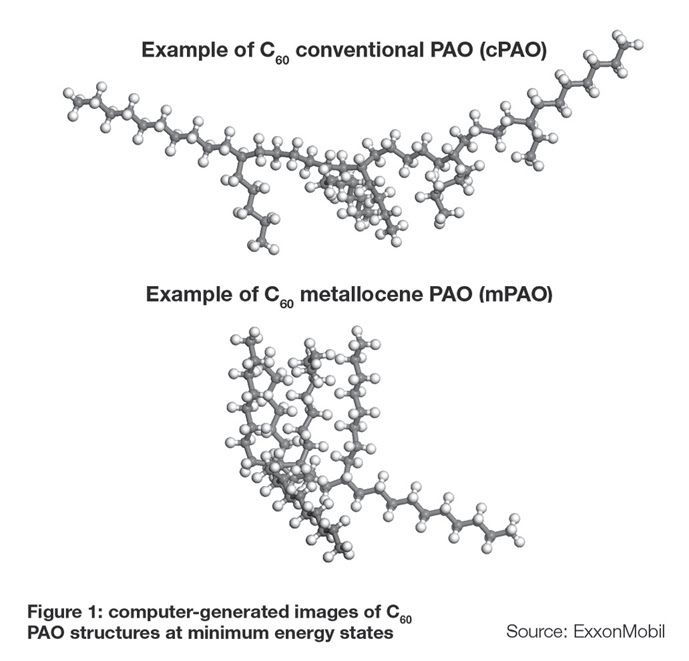 Figure 1.
Why 65 and 150 cSt mPAOs?
Figure 1.
Why 65 and 150 cSt mPAOs?
Leveraging over 20 years of experience with metallocene catalysts, Exxon Mobil Chemical understands the structure of metallocene-catalyzed PAOs, and has designed products with better thickening effect than conventional PAOs.
Blend studies demonstrate how SpectraSyn Elite 65 and 150 offer potential cost savings and enhanced performance in the finished lubricant. Also, at high viscosities, these products enable formulators to use a single base stock to manufacture various common industrial viscosity grades, providing opportunities to rationalize blending stocks, which can lower logistics costs.
Figure 2 shows the percentages of high-viscosity component (x-axis) required to meet the viscosity range of various ISO VG grades (y-axis) when blended with a 6 cSt PAO. The green line shows the amount of 100 cSt PAO (cPAO 100) required to make different ISO VG grades. For example, producing an ISO VG 320 grade requires about 60% cPAO 100. When using a 100 cSt mPAO (red line) to make the same grade, almost 10% more mPAO may be needed due to the compact structure. To compensate, SpectraSyn Elite 150, at 150 cSt, has almost the same blending characteristic as cPAO 100. SpectraSyn Elite 65 offers a similar blend-efficiency profile.
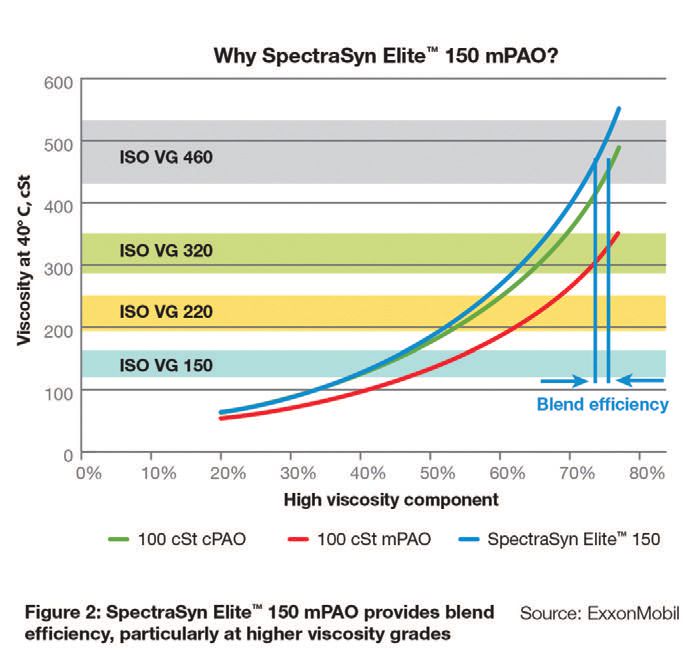 Figure 2.
Properties enhanced with mPAOs
Figure 2.
Properties enhanced with mPAOs
ExxonMobil Chemical’s mPAOs demonstrate higher VI than conventional PAOs, as well as lower pour point and Brookfield viscosity, allowing formulators to tackle lubricant challenges such as extreme operating temperatures, longer drain intervals and improved energy efficiency (
Table 1).
Table 1.
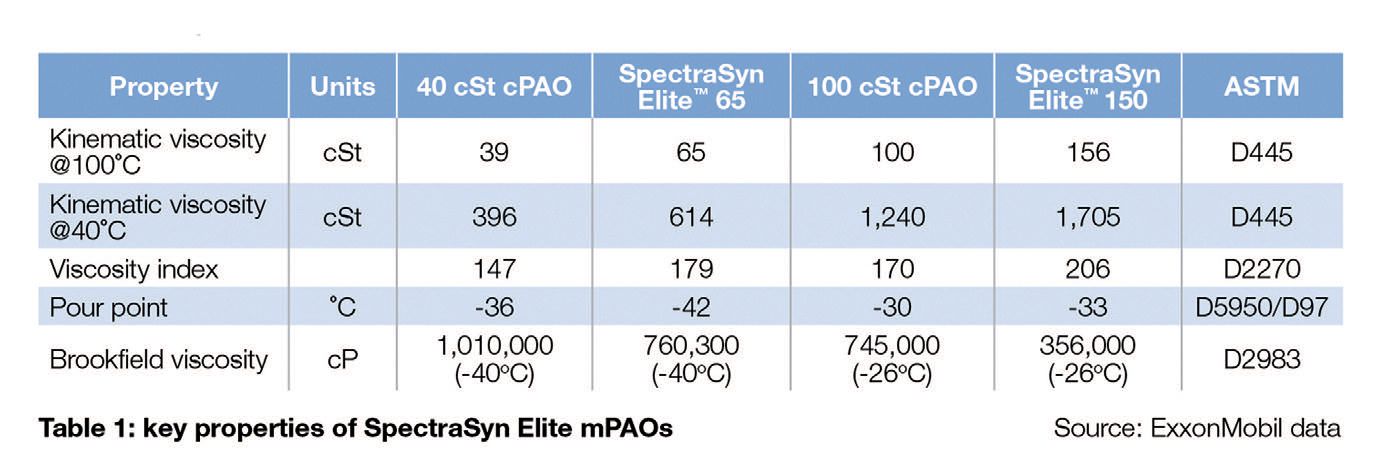 Enhanced VI and shear stability in automotive gear oil
Enhanced VI and shear stability in automotive gear oil
Multigrade lubricants such as 75W-90 and 75W-140 are used to cover a wide range of operating temperatures in auto motive gears, and usually require either special high VI base oils or VI improvers. SpectraSyn Elite mPAOs improve the VI of finished automotive gear oils (
Figure 3). At low starting temperatures, the higher VI mPAO-formulated oils allow rapid flow to gear teeth and bearings, providing immediate protection and energy savings from better fluidity. As temperature increases, mPAO-formulated oils thin out less, providing better wear protection.
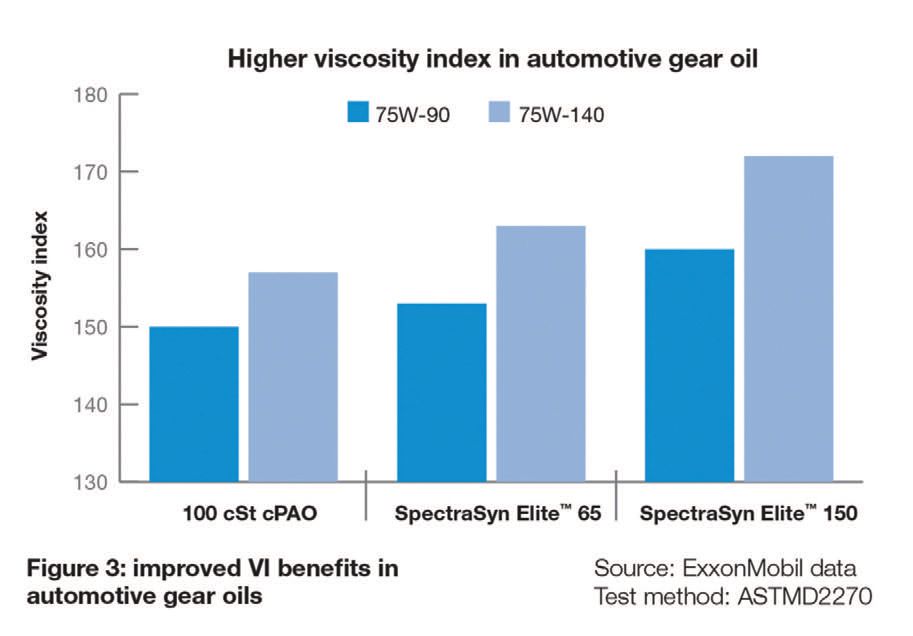 Figure 3.
Figure 3.
Viscosity index improvers (VII) are often added to boost VI. Under the severe mechanical shearing in gears, the large VII molecules are subject to mechanical stresses that break molecular chains, resulting in permanent viscosity loss. The ability to resist such degradation and retain viscosity is known as shear stability. SpectraSyn Elite mPAOs have better shear stability than most VII.
Low-temperature properties
The more compact molecule and uniform structure help improve mPAOs’ low-temperature fluidity. Pour points for SpectraSyn Elite mPAOs are approximately 10-12°C lower than for equivalent- viscosity cPAOs. The lower Brookfield viscosity of the mPAO products improves fluidity at low temperatures, which increases energy savings in cold conditions and better cold-start protection (
Figure 4).
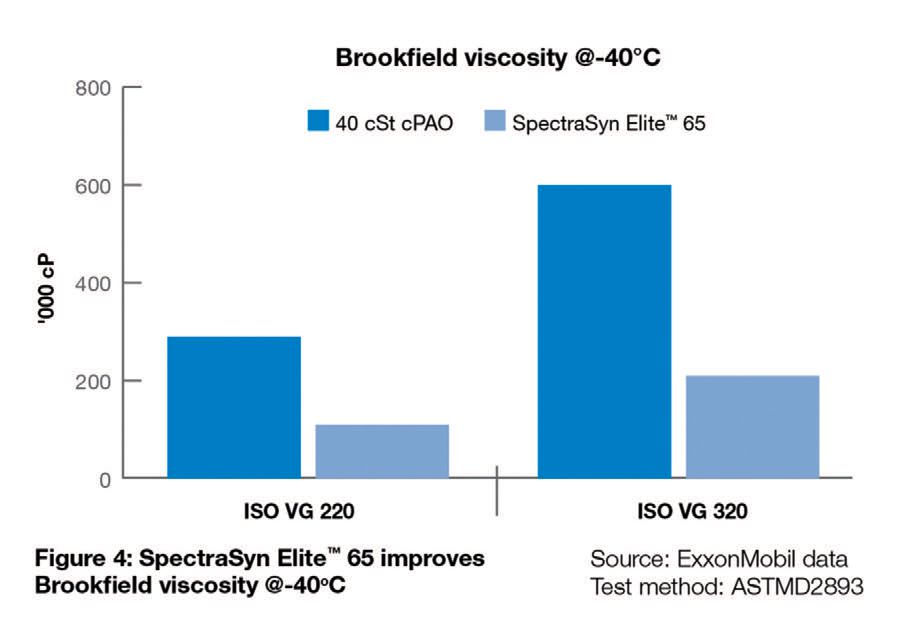 Figure 4.
Improved low-temperature fluidity in grease
Figure 4.
Improved low-temperature fluidity in grease
The excellent low-temperature fluidity in lubricants using SpectraSyn Elite™mPAOs is also achievable in greases. The torque required to turn a test bearing is lower when SpectraSyn Elite mPAO is used, compared to conventional PAO grease.
Enhanced air release and foaming characteristics
Foam and air release performance are important, since excessive foam/air impacts lubrication, oxidation and compressibility. SpectraSyn Elite mPAOs demonstrate good foaming and air release characteristics. As viscosity increases, it is more difficult for air to escape, thus increasing air-release times. Similarly, foam response tends to increase with viscosity. However, test data show that the structure of SpectraSyn Elite mPAOs allows better air release properties than conventional 40 and 100 cSt PAOs, and minimal foam production.
Summary
Energy-efficient machinery, equipment and vehicles place increasingly tougher demands on lubricants. To meet these demands, ExxonMobil Chemical has drawn on two decades of metallocene catalyst experience to develop SpectraSyn Elite 65 and 150 mPAO base stocks. Differences in the molecular structure and thickening efficiency give SpectraSyn Elite products distinct performance benefits over high-viscosity cPAOs. Their true benefits are fully realized, however, through combining the improved properties with enhanced blending benefits. Advanced lubricants with SpectraSyn Elite mPAOs can help end-users save energy and lower maintenance costs through improved equipment reliability and reduced downtime.
Demonstrating its long-term commitment, ExxonMobil Chemical will expand the global supply of mPAOs in 2014 with its 50,000-ton/yr plant in Baytown, Texas. ExxonMobil Chemical helps customers deliver innovative lubricants to meet the energy challenges of today and tomorrow.
Visit
exxonmobil.com/synthetics
©2013 ExxonMobil. ExxonMobil, the ExxonMobil logo, the interlocking “X” device and other product or service names used herein are trademarks of ExxonMobil, unless indicated otherwise. This document may not be distributed, displayed, copied or altered without ExxonMobil’s prior written authorization. To the extent ExxonMobil authorizes distributing, displaying and/or copying of this document, the user may do so only if the document is unaltered and complete, including all of its headers, footers, disclaimers and other information. You may not copy this document to or reproduce it in whole or in part on a website. ExxonMobil does not guarantee the typical (or other) values. Any data included herein is based upon analysis of representative samples and not the actual product shipped. The information in this document relates only to the named product or materials when not in combination with any other product or materials. We based the information on data believed to be reliable on the date compiled, but we do not represent, warrant, or otherwise guarantee, expressly or impliedly, the merchantability, fitness for a particular purpose, freedom from patent infringement, suitability, accuracy, reliability, or completeness of this information or the products, materials or processes described. The user is solely responsible for all determinations regarding any use of material or product and any process in its territories of interest. We expressly disclaim liability for any loss, damage or injury directly or indirectly suffered or incurred as a result of or related to anyone using or relying on any of the information in this document. This document is not an endorsement of any non-ExxonMobil product or process, and we expressly disclaim any contrary implication. The terms “we,” “our,” “ExxonMobil Chemical” and “ExxonMobil” are each used for convenience, and may include any one or more of ExxonMobil Chemical Company, Exxon Mobil Corporation, or any affiliate either directly or indirectly stewarded. Photos used in this brochure are representative of potential product applications only.